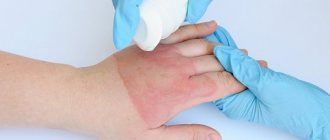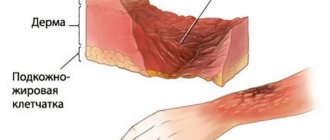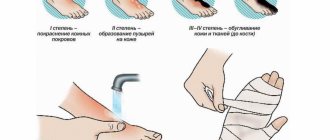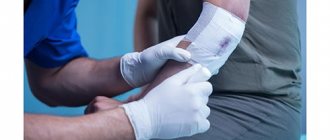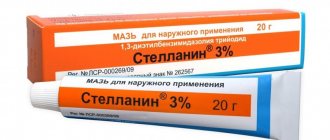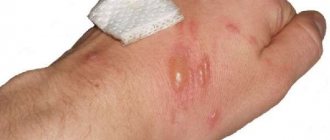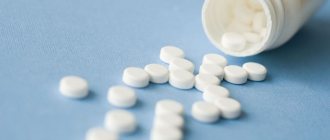Burns from boiling water, hot oil or any other hot liquids require an adequate and timely response, and if this happens, first aid should be provided immediately. Both the depth of tissue damage and the area of damage, as well as the healing period, will depend on this.
If this is a minor injury, you can provide first aid for a hand burn with boiling water yourself, but for serious injuries (3rd-4th degree burns), you should trust the doctors. Under no circumstances should the resulting blisters be opened, as this can lead to tissue infection. It is forbidden to sprinkle starch on burns, treat the wound with vegetable oil, iodine and other alcohol-containing liquids. All this can only increase pain and slow down healing. In case of particularly deep burns, when dirt and fragments of clothing have entered the wound, you should not try to clean the wound yourself, but rather wait for the doctors to arrive.
Stages of first aid for burns with boiling water
First aid for a burn with boiling water should be provided in stages, following the following sequence of actions:
- Remove clothing that has been doused with boiling water to eliminate the risk of it sticking to the wound.
- Place the wounded area in a container of cold water or under running water to relieve pain and stop tissue damage.
- If you have an anti-burn agent in your home medicine cabinet, such as Branolind, apply a bandage to the wound.
- Secure the bandage with a bandage or plaster.
- If the burns are large and deep, taking painkillers is acceptable.
When you need medical help for a burn with boiling water. The faster first aid is provided for a burn with boiling water, the more favorable the prognosis.
It is important to first assess the extent of skin damage. Doctors distinguish 4 degrees of burns, each of which has its own characteristic signs. By knowing them, you can determine the severity of the problem and act accordingly.
- Burn degrees:
Slight redness and swelling, rarely small blisters.
- Redness and swelling, which are accompanied by blisters and a thin scab.
- Deep tissue damage, right down to the muscles. There is always a scab and blisters burst.
- The lesion reaches the bone, and areas of the skin die. Possible blackening and charring of tissues.
First aid at home for burns with boiling water can be provided for grades 1 and 2, when up to 1% of the body area is damaged. This is an area no larger than the palm of your hand. The exception is burns of the face, feet and genitals. Even with mild damage, scars can form here.
If the burn at first glance can be attributed to 3-4 degrees, you need to immediately call an ambulance.
Remedy for burns - we act quickly and correctly
The most important structural component of cells is proteins. Their “representatives” collagen and keratin provide physical protection to the body by forming a structural framework that maintains the shape of cells. At temperatures above 44 degrees, proteins lose their three-dimensional shape and are destroyed. This leads to damage to cells and tissues, which occurs with any, even the mildest burn.
Depending on the depth of the injury, there are several degrees of severity of the burn.
First degree burns
the most innocent ones. With them, only the upper, keratinized layer of the epidermis is damaged. Manifested by redness, pain and slight swelling. After a few days, not a trace remains of them.
Second degree burns
characterized by damage to the epidermis to the deeper, germinal layer. Lymph and, less commonly, blood from destroyed cells penetrate upward, forming blisters. These burns heal after 1–3 weeks.
For third degree burns
not only all layers of the epidermis are affected, but also the underlying dermis, in severe cases down to the subcutaneous fatty tissue. The third degree is characterized by large blisters, which often open to reveal dense white or brown tissue.
What can you do at home?
Considering that not everyone has the opportunity to purchase expensive pharmaceutical drugs, you can use home remedies to help with a burn from boiling water. However, such products, even if they are used to treat 1st degree burns, do not act as effectively and quickly as ointments and sprays intended for this purpose, and treatment of more serious lesions should be carried out exclusively with specialized products under the supervision of a physician.
One of these products used to provide first aid for a household burn on a small area of the body is household burn plasters from HARTMANN.
Traditional recipes for the treatment of burns
For burns from boiling water, folk remedies are very popular due to the availability of ingredients and ease of use. Almost everything needed for the recipe can be found in any kitchen or local store. Using folk recipes, you can treat a 1st degree burn with boiling water or use it as additional therapy for more serious injuries.
In any case, herbal decoctions, homemade ointments and lotions do not replace drug treatment and you should consult a doctor before using them.
How to quickly cure a burn with boiling water using folk remedies at home:
- Wax-based oil ointment . To prepare this product you will need 50 ml of any vegetable oil, 40 g of natural wax and hard-boiled chicken yolk. To mix the ingredients, you will need to melt the wax, pour oil into it and only then add carefully crushed yolk. The mixture is shaken until a homogeneous consistency is obtained and allowed to cool. The ointment is stored in the refrigerator and used for compresses.
- Compress with wax and oil . To prepare the medicinal mixture, you will need vegetable oil and wax in a ratio of 3 to 1. Both ingredients are mixed on the stove until the wax has completely melted; when the mixture is ready, it is allowed to cool. The prepared ointment is applied to a clean bandage and applied to the burn site.
- Fresh carrot gruel . Two medium-sized carrots must be grated on a fine grater and placed evenly on a bandage. The compress is applied to the burned skin and kept for 2 hours. Carrot juice will help relieve inflammation and pain.
- Homemade ointment with oil and propolis . To make this product, you will need 100 ml of sunflower oil, 100 g of butter, 100 g of pork fat and 10 g of wax. All ingredients are added one by one to the pan until completely dissolved and mixed thoroughly. Add 1 teaspoon of propolis to the melted butter with fat and wax, mix well, and then remove the pan from the heat. When the ointment cools and thickens, it can be rubbed into the wound. Helps with crusts after opening blisters.
- Plantain compress - fresh plantain leaves need to be washed well, dried and mashed until the juice comes out. If necessary, you can use a blender to grind the leaves into a pulp. The mixture is applied to the burn for 30 minutes 3 times a day, then the leaves are carefully removed. The juice should be completely absorbed into the skin.
- Aloe. It is safer to treat burns on a child with fresh aloe leaves. To do this, take the fleshy leaves of the plant without thorns and grind them to make it easier to squeeze out the juice. The juice must be diluted with water in equal proportions, after which a cotton pad soaked in the solution is applied to the burn. Aloe juice accelerates skin restoration and relieves inflammation.
- Potato starch . You need to grate regular raw potatoes. The pulp is wrapped in gauze and applied in this form to the burn for 10 minutes every 3 hours. After the starch compress, the skin is washed with water and antiseptic agents are applied.
The following remedies are also used for burns:
- Black tea. Relieves swelling and inflammation; to do this, you need to lubricate the burned area with a strong tea solution 8 times a day;
- Egg . To treat a burn at home, I use an ordinary raw egg, for which the white is separated, beating it until foamy. This foam is applied to the burn;
- Blueberry . Wild berries will help relieve pain from mild burns from boiling water. It is enough to take 100 g of blueberries, cook for 10 minutes and mash into a paste. The resulting product is applied to the burned skin;
- Oak bark. A burn can be cured by using a decoction of oak bark in the form of compresses. To prepare one serving of the product, use 40 g of bark and 200 ml of boiling water. The mixture should simmer over low heat for 10 minutes, then it is allowed to cool and filtered through cheesecloth;
- Pumpkin pulp . An even thick layer is applied to the injured skin and fixed with a bandage for 20 minutes. It is important to wait until the vegetable juice is absorbed into the skin. Remains of pumpkin pulp are carefully removed with wet wipes;
- Onion dough. Burns from boiling water can be cured with green onions. To prepare the mixture for the compress, you need to finely chop the greens and boil them in 100 ml of water. When the broth is ready, add a little flour to it to form a sticky dough-like mass. This is applied to the burned skin and held until the mixture is completely dry;
- Lentils and beets. Boiled lentils mixed with grated beets are applied to the affected skin for 20 minutes, after which the paste is washed off.
Folk remedies should be used with caution, as some components can cause allergies. Before applying homemade ointments to a sore spot, it is advisable to consult a doctor.
4.Treatment
First aid should include immediate cessation of contact with the damaging factor, pain relief (rinsing the affected area with clean cold, but not ice water) and prevention of infection.
It is strictly contraindicated to touch burnt surfaces with your hands, to open blisters yourself, to lubricate them with anything, etc. Immediately after a burn, if possible, an alcohol lotion is necessary, then the affected surface is covered with a clean (ideally sterile) cloth, but not cotton wool.
Further treatment of burns, starting from the second degree, requires hospitalization in a specialized combustiology center or department. Antitetanus serum, anti-inflammatory, analgesic, antibiotic, blood replacement and other agents necessary in this individual case are administered. According to indications, artificial ventilation of the lungs is used, measures are taken for detoxification and prevention of life-threatening complications. In severe cases, emergency surgery with necrectomy (removal of dead tissue) is performed. After eliminating the immediate threat to life and scarring of the affected structures, plastic surgery is planned to eliminate the cosmetic defect as much as possible.
The prognosis and outcome vary very widely, since they depend on many factors (the extent and depth of the lesion, the degree of necrosis, the timeliness of care, the general condition of the patient, complications that have developed, etc.).
Treatment of severe burns with boiling water
Third- and fourth-degree burns are treated only in a hospital. Immediately upon admission, the patient is given anti-shock therapy and given painkiller injections.
To treat burn lesions in the face and perineum, where the skin is especially thin and sensitive, only the open method is used (without using a bandage). Use antiseptic ointments and petroleum jelly, which are applied to the affected areas three times a day.
Surgical treatment of severe burns (grades 3 and 4B) is aimed at excision of necrotic tissue and correction of the defect, after which plastic surgery is performed. The main tasks in the treatment of burns are to remove toxic substances, prevent suppuration and inflammatory processes in the wound area, accelerate healing and remove dead areas.
Author of the article:
Volkov Dmitry Sergeevich |
Ph.D. surgeon, phlebologist Education: Moscow State Medical and Dental University (1996). In 2003, he received a diploma from the educational and scientific medical center for the administration of the President of the Russian Federation. Our authors
Classification of burns
The severity of the injury is determined by the depth of damage to the skin. To provide effective assistance, it is necessary to correctly classify the burn:
- I degree. Slight redness of the skin area, swelling, mild pain. The consequences disappear without a trace after 3–7 days.
- II degree. Severe pain associated with the appearance of watery blisters. The deep layers of the skin are not damaged, which eliminates the formation of scars. Characterized by a change in skin color that occurs over time.
- III degree. The symptoms are many times greater than those listed above. Tissue death occurs and scabs and open wounds appear. The skin recovers poorly, forming dense scars.
- IV degree - charring. It is considered the most difficult to cure. In most cases, skin grafting is required. The injury affects the tissues of the muscles, tendons and bones.
In domestic conditions, first and second degree burns more often occur, but it is important to note that incorrectly provided or untimely assistance can lead to infection of the damaged area and serious consequences even with a second degree burn. If you are injured, it is important to see a doctor as soon as possible.
What is the danger
- If the mucous membranes of the throat or nose are affected, there is a high probability of swelling. It spreads quickly and makes breathing difficult. Up to the point of suffocation.
- When ingested or inhaled vapors of acids and alkalis, damage to the nasopharynx and throat is usually combined with deeper damage to the trachea, esophagus and other internal organs. Necrosis of esophageal tissue and perforation are possible.
- External burns cause intoxication and take a long time to heal without proper treatment. The wound surface becomes infected.
- If the lesions are strong and extensive, a painful shock occurs.
2. Reasons
Burn damage to the tissues of the external nose can occur under the influence of a number of physical and chemical factors. The most common are burns from contact with hot liquids, vapors, metals, or open fire itself. Such burns also include skin damage due to excessive insolation (stay in direct sunlight), which is aggravated by the harmful effects of ultraviolet radiation on the skin. Somewhat less common is a chemical burn caused by exposure to aggressively corrosive compounds with a sharply acidic or alkaline pH. Finally, the rarest cases of nasal burns are electrical and radiation injuries.
Visit our Otolaryngology (ENT) page
1.General information
In humans, the external nose - root, wings, walls, dorsum, vestibule, apex - has as an anatomical frame a dense osteochondral structure, somewhat protruding anteriorly from the frontal, maxillary and zygomatic bones.
Therefore, normally, any nose, with all the individual and racial differences in shape and size, protrudes forward to one degree or another - and is the first to suffer from frontal impacts, gets frostbitten in the icy wind, and “burns” under the scorching rays of the sun. And although nasal injuries are most often combined with ophthalmic trauma, maxillofacial trauma, facial skin burns, respiratory tract damage and other injuries, burns of the external nose constitute a separate problem for a number of medical specialties (otolaryngology, combustiology, traumatology, plastic surgery).
A must read! Help with treatment and hospitalization!
Treatment in hospital
The decision about what kind of dressing to apply to the site of a severe burn in a hospital setting is made only by medical specialists. Thus, for the treatment of dermal superficial and dermal deep (2nd and 3rd degree) burns under the supervision of a physician, it is recommended to apply a sterile bandage.
It is most preferable to use the sterile wound covering Aquacel Bern (in the form of a rectangular plate), made using the special Hydrofiber technology. Despite the fact that the coating is very thin, it is capable of absorbing a large amount of wound discharge and providing a moist environment for faster and better healing.
Thanks to the stitching, the coating remains intact while on the wound surface, even during physical activity. The use of Aquacel Bern eliminates the need for frequent dressings, since it can remain on the wound for up to 21 days, that is, until the wound is completely healed. More detailed information can be obtained by watching the video in the “Webinars” section.
